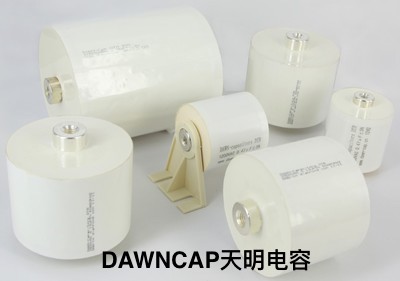The application of DAWNCAP Tianming capacitance in the wireless charging pile of new energy vehicle
The new energy automotive wireless charging pile will be the first year of the development of new energy vehicles in 2018, will be the rapid development, we will continuously improve products, build quality, product configuration for manufacturers to do!

The wireless charging technology of electric vehicles will be popularized.
DAWNCAP Tianming, Shenzhen Tianming Weiye Electronics Co., Ltd. is a professional manufacturer engaged in R & D, production and sales of high frequency capacitors, which specializes in providing high quality film capacitors for all manufacturers.
The history of wireless charging dates back to 1901. Nicola Tesla set up a wireless rechargeable battery tower in Long Island, New York, for a wireless transmission test by Worden Cliff Kobita, although the project ended in failure.
After a century, the study of wireless charging ushered in the new source of power, the application range is very wide, small electric toothbrush, remote control, intelligent mobile phone, to electric vehicles, oil rigs. Industry giants TOYOTA, Nissan, Volvo, Intel and Samsung have all joined the R & D ranks. In the country, Beijing is studying the use of a wireless charging system on some microcirculation buses. Zhengzhou, Yunnan and other places will also introduce wireless charging technology, Chengdu, Xiangyang and other places have opened wireless charging lines.
The principle of wireless charging
Wireless charging can be divided into four ways:
1, electric field coupling; 2, electromagnetic induction; 3, magnetic resonance; 4, radio wave.
The transmission power of electric field coupling and radio wave is small, and it has not been used in electric vehicles at present. The wireless charging technology for electric vehicles is mainly composed of electromagnetic induction and magnetic resonance.
Four main modes of wireless charging
In July 2014, Mercedes Benz and BMW jointly announced that it would cooperate to develop the wireless charging technology for electric vehicles. Mercedes Benz says it will be tested on a new S level, while BMW is planning to take the lead in I8. The two sides say they will achieve commercial production in the next 2-3 years. Audi and Mercedes BMW wireless charging function is similar, but Audi brilliance is that this set of equipment can be automatic lifting, in order to improve the charging efficiency, because the transmission of power supply efficiency with coil and the receiving coil is inversely proportional to the distance, the closer the coil charging efficiency is high
.
In terms of Japanese vehicles, Toyota Corporation also joined the ranks of wireless charging in 2014. Due to the high requirement of location for wireless charging technology, TOYOTA developed a parking auxiliary function, which can display the location of the transmitting coil on the central control display screen for the driver to aim at parking. Honda's wireless charging technology uses magnetic resonance. When the transmitter and the receiver have the same resonant frequency, energy can be transmitted. According to Honda, as long as 80% of the area overlaps, it can be charged for the vehicle. Therefore, the position requirements are relatively low and support one to many charging.
The development of the dispute and the boundless prospect
From the radio transmission since the invention has been controversial, many people suspect that the Tunguska event is caused by Tesla wireless power transmission test. The same wireless charging technology in the promotion of electric vehicles is also controversial, the traditional car factory most passionate for wireless charging, but Tesla Motors seems to be on the wireless charging technology is not a cold, especially CEO Elon Musk that wireless charging technology and super charging station than charging Wireless charging is a kind of low efficiency and low energy ".
The main reasons for the objection are 3 aspects:
1. the charging efficiency is not high, the peak efficiency is about 90%, while the traditional charging efficiency is about 95%.
2., the transmission power is not big enough. In the current technology, most of the transmission power is generally below 10kW. On the electric vehicle, wireless charging is generally slow charging. This power is to meet the demand, and with the development of technology, the power will also continue to improve.
3. security problem, vehicle wireless charging mainly adopts electromagnetic mode, and there is a problem of radiation leakage.
In the same way, the advantages of wireless charging are very obvious, especially the advantages of parking lots in public places will be very obvious.
1. the charging equipment is small, and the charging convenience is high.
2. the charging facilities can be unattended, and the cost of later maintenance is low.
3., under the same floor area, compared with the traditional charging pile charging, the number of electric vehicles that can be charged by wireless charging has been increased, and the space utilization rate has been increased.
From the rising trend of wireless charging technology in the field of consumer electronics, the new technology will also develop rapidly in the automotive industry, and the popularity of electric vehicles has opened up new market opportunities for wireless charging technology. SAE SAE after consulting with car manufacturers, wireless charging technology companies and electricity suppliers, establish the future automotive wireless charging service industry standards, namely, the output power is less than or equal to 20kW, the operating frequency of 85kHz.
The first batch of vehicles carrying the standard wireless charger are expected to come in 2017 or 2018.
epilogue
Life changing technology, wireless charging technology as a way of charging cool and convenient will gradually in electric vehicles equipped with the application, we will also pay close attention to the development of wireless charging, wireless charging technology can expect in the near future to popularize.
.

